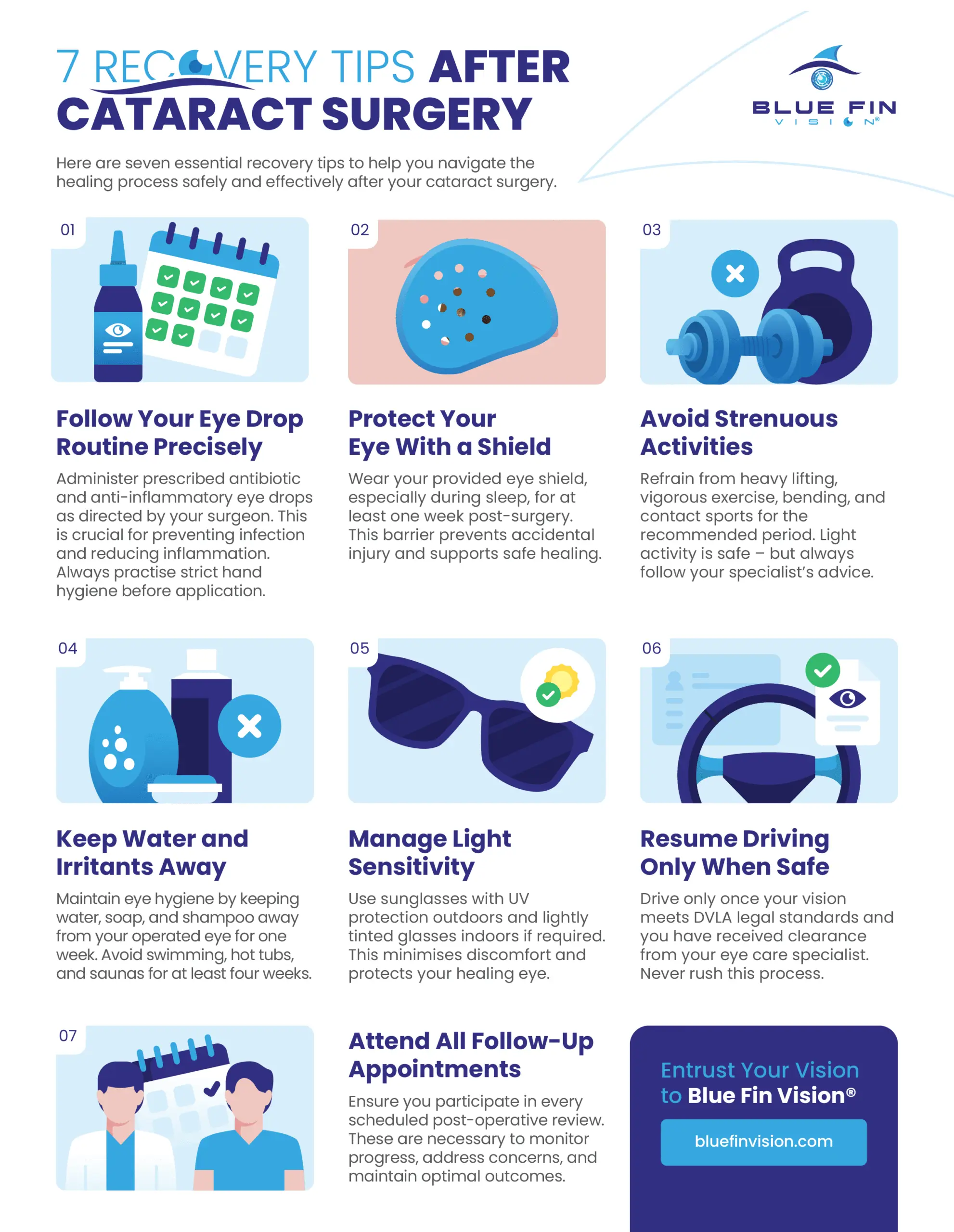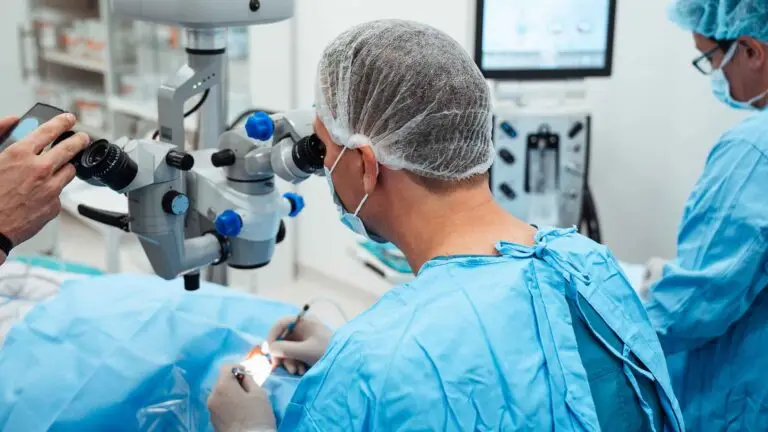
- Medically Reviewed by Mr Mfazo Hove Consultant Ophthalmologist
- Author: Chris Dunnington
- Published: August 18, 2025
- Last Updated: August 31, 2025
Cataract surgery is one of the most successful and commonly performed procedures in modern medicine, offering remarkable improvements in vision and quality of life. At Blue Fin Vision®, our leading surgeons at our premier London clinics on Harley Street and Weymouth Street, as well as our facilities in Chelmsford and Hatfield, understand that proper post-operative care is essential for achieving optimal results. The recovery period requires careful attention to specific guidelines to ensure your eyes heal properly and your vision improves as expected.
Here are seven essential recovery tips to help you navigate the healing process safely and effectively after your cataract surgery.
Infographic: 7 Recovery Tips After Cataract Surgery
1. Follow Your Eye Drop Regimen Religiously
Consistent use of prescribed eye drops is your most important recovery tool. Your ophthalmologist will prescribe antibiotic and anti-inflammatory drops that serve crucial functions in preventing infection and reducing inflammation during the healing process. These drops typically need to be administered multiple times daily for several weeks following your procedure. The antibiotic drops help prevent bacterial infections that could compromise your surgical results, whilst the anti-inflammatory drops reduce swelling and discomfort. Always wash your hands thoroughly before applying drops and be careful not to touch the dropper tip to your eye or any surface to maintain sterility. Store your drops according to the instructions, with some requiring refrigeration to maintain their effectiveness.
2. Protect Your Eye with Proper Shielding
Wearing your protective eye shield consistently, especially at night, prevents accidental injury during the vulnerable healing period. Your eye clinic will provide you with a transparent protective shield that should be worn whilst sleeping for at least one week following surgery. This shield acts as a physical barrier, preventing you from inadvertently rubbing or pressing on your eye during sleep, which could disrupt the healing process or displace the new intraocular lens. During the day, wearing sunglasses outdoors protects your sensitive eye from bright sunlight, UV rays, and airborne irritants like dust and pollen. The shield should be cleaned daily with mild soap and warm water, then secured with surgical tape across your forehead and cheek rather than directly over the eye area.
3. Avoid Strenuous Activities and Heavy Lifting
Restricting physical activity during the first two weeks prevents increased eye pressure that could compromise healing. Strenuous activities such as heavy lifting (anything over 10 pounds), vigorous exercise, bending over frequently, or any activity that causes you to strain can increase intraocular pressure, potentially affecting your surgical site. Light activities such as gentle walking, reading, and watching television are perfectly acceptable and won’t harm your recovery. Most patients can gradually return to normal activities between two to four weeks post-surgery but always follow your surgeon’s specific recommendations based on your individual healing progress. Contact sports and swimming should be avoided for at least four to six weeks to prevent injury and infection risk.

4. Keep Water and Irritants Away from Your Eye
Proper eye hygiene prevents infection whilst allowing your eye to heal naturally. For the first week after surgery, it’s crucial to keep your eye completely dry and avoid getting soap, shampoo, or water directly in the operated eye. When showering or washing your hair, use the “salon style” method by tilting your head back over a sink or having someone assist you to prevent water from running into your eyes. If your eye becomes sticky due to normal healing discharge, gently clean around the eye area using cooled, boiled water and clean gauze or cotton wool, wiping from the inner corner outward. Avoid swimming pools, hot tubs, saunas, and natural bodies of water for at least four weeks, as these environments can harbour bacteria that could cause serious infections.
5. Manage Light Sensitivity with Dark Glasses
Protecting your eyes from bright light reduces discomfort and supports the healing process. Following cataract surgery, many patients experience increased sensitivity to light, which is a normal part of recovery. Wearing quality sunglasses with UV protection when outdoors helps reduce glare and provides comfort during this adjustment period. Even indoors, you may find that wearing lightly tinted glasses helps with comfort, particularly around bright lights or computer screens. While sunglasses aren’t absolutely necessary after surgery, patients who find lights overly bright or discomforting typically benefit from wearing them consistently for the first two weeks, then gradually reducing usage as sensitivity diminishes. The top specialists at Blue Fin Vision® recommend having your sunglasses ready before your surgery date, as this sensitivity can occur immediately after the procedure and make bright environments uncomfortable.

6. Understand When You Can Resume Driving
Returning to driving requires meeting legal vision standards and receiving clearance from your eye specialist. Whilst many patients notice vision improvements within 24 hours, you cannot legally drive until your vision meets DVLA requirements, which include being able to read a car number plate from 20 metres away. This assessment should be conducted by your ophthalmologist or optician during your follow-up appointment, typically scheduled within one to two weeks after surgery. If you have surgery on only one eye and your other eye has good vision, you may be cleared to drive relatively quickly. However, if you previously wore very strong prescription glasses, the difference in vision between your treated and untreated eye may make driving unsafe until your second eye is treated or until you receive appropriate corrective lenses.
7. Attend All Follow-Up Appointments
Regular monitoring by your eye care team ensures optimal healing and early detection of any complications. Your follow-up schedule typically includes an examination within the first few days after surgery, then again at one to two weeks, and possibly at one-month post-surgery. These appointments allow your surgeon to monitor your healing progress, check your intraocular pressure, assess the position of your new lens, and address any concerns you may have. During these visits, your visual acuity will be tested to ensure your vision is improving as expected. The leading specialists at our London, Chelmsford, and Hatfield clinics use these appointments to make any necessary adjustments to your post-operative care plan and determine when you can safely resume various activities. Never skip these appointments, as early detection of any issues is crucial for maintaining excellent surgical outcomes.

Your Path to Clear Vision with Blue Fin Vision®
Recovery from cataract surgery requires patience, diligence, and expert guidance from experienced professionals. By following these seven essential recovery tips, you’ll optimise your healing process and maximise the benefits of your procedure. Remember that every patient’s recovery timeline is unique, and what matters most is adhering to your surgeon’s specific instructions and maintaining open communication about any concerns.
At Blue Fin Vision® Eye Clinic, our top-rated surgeons and specialists are committed to providing exceptional care throughout your entire cataract surgery journey. With locations in London’s prestigious Harley Street and Weymouth Street, plus convenient clinics in Chelmsford and Hatfield, we combine advanced surgical techniques with personalised aftercare to ensure the best possible outcomes for our patients.
Ready to trust your vision to the UK’s leading eye care experts? Contact Blue Fin Vision® today to schedule your consultation and discover how our world-class team can help restore your clear vision with confidence and precision.



